Why Is Cloud Computing The Hot Topic Nowadays In The Market?
Here we will discuss what is cloud computing in which we will be discussing about the foundation topics of cloud computing like what is cloud hype, the history about the foundation topics of cloud computing like what is cloud hype, the history about cloud computing, common cloud characteristics, on-demand self-service, rapid elasticity, resource pooling, etc.
Let us understand the very basics of cloud computing, for example, suppose you want to fly from one place to another so you will be purchasing the whole airline or what you will do, so obviously you would be purchasing the flight ticket and then travel. So, this means that if you want a particular compute infrastructure or network infrastructure then you can hire the resources as per your requirement.
Any application requires network or compute infrastructure that could provide quick response between client and user, they need a spread of network from one branch to another and from head offices to branch offices. The overall goal is to increase the profit but at the same time to decrease the infrastructure cost and other costs involved in the operations. So, the ultimate benefit of having the cloud infrastructure is to just use the infrastructure whenever is required during a particular period and release it when it is not, this way you will pay only for what you will use.
What do we understand by Cloud Computing?
- On demand network access to a shared pool of configurable computing resources like network, servers, storage, applications, and services.
- Cloud computing allows end-users to immediately provide any IT resource without any base infra investment.
- End users only must pay for the actual use of resources which can be easily decommissioned as soon as the users do not need them.
Traditional IT Challenges
In a world where information technology is expensive, complex, and rigid due to:
Low Efficiency, High Cost, and Lack of Agility.
Although IT systems are expensive, their overall utilization is low because hardware and software are sized according to business activity peaks. While other parts of the organization already used consumption-based models, IT infrastructure usually requires heavy investment before any system is available and due to its extreme complexity, IT remains the least flexible link in the chain when compared to other parts of the organization.
Though you have invested a lot of in IT infrastructure like routers, servers, security appliances, etc what is the overall outcome this means when you see your premises or overall infrastructure you will realize that the most expensive infrastructure is the IT department. So, do you think that the infrastructure you have invested in, is efficient enough to meet all your present and future needs and you do not have to buy additional resources to scale your IT requirements?
We’ll now learn about Cloud Computing Evolution
Cloud Characteristics

- On Demand Self-Service
End users can directly ask for the resources from the cloud portal and services will be made available through the cloud provider.
- Rapid Elasticity
- Elasticity denotes the quality of an object to change and adapt to a new situation.
- Traditional IT management may receive additional resources to fulfill change requests from end-users.
- Cloud has the scalable infrastructure to adopt for any additional requirements from end-users.
- Resource Pooling
- Refers to a set of computing resources (Storage, Processing, Memory & Network Bandwidth) that work in tandem as one big resource shared by many users.
- No need of having dedicated resources for each customer can have distributed architecture for multiple customers over the same hardware.
- These distributions of customer architectural requirements are called Tenant.
- Measured Services
- The customer gets what they pay for.
- Resource usage can be monitored, controlled, and reported.
- Increases visibility over their true IT demand and usage.
- Measured services allow the organization to set the demand of resource utilization based on their peak and non-peak time frames.
- Broad Network Access
- This allows complete visibility of all network resources spread across the globe so that any resource can be accessed from any location and that too nearest resource eliminating the latency and delayed outcomes.
Multi-Tenancy
What is a Tenant?
- It is defined as an application environment that requires some form of isolation from the outside world which includes all other tenants.
- A tenant can be an organization, a single department, or any other subdivision that requires segregation within an IT system or application.
- Multi-tenancy refers to the capacity of its resources to support multiple tenants according to an accepted isolation technique.
Cloud Classification
- Service Models – According to the nature of services provided to consumers for example IAAS (Infrastructure as a Service), PAAS (Platform as a Service), and SAAS (Software as a Service).
- Deployment Models – These models are classified according to who the cloud infrastructure is provided for (Public, Private, Community, or Hybrid).
This brief discussion concludes with an overview of cloud computing that might help us to understand the benefits of using or moving towards cloud infrastructure instead of having own dedicated IT infrastructure to fulfill the requirement of organization’s resources whether it is related to Networks, Servers, Storages, Virtualizations, Operating systems, Software, and Applications. We will produce a detailed discussion on the cloud infrastructure where we will discuss more on Service Models and Deployment Models. Stay in touch with us or you can also reach out to us and you can get data center services, cloud solutions, managed IT services, IT Consultant, Network infrastructure, IT security, and cyber security from us along with other services. Visit our website for more IT infrastructure solutions that we provide and give us a call on +91- 9773973971.
Author
Rajat Goyal
Project Lead
